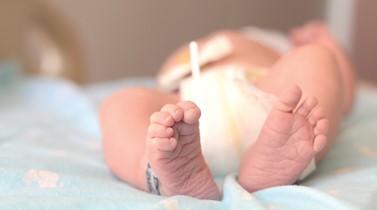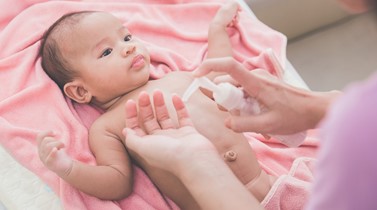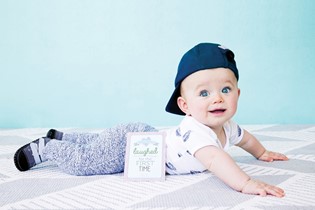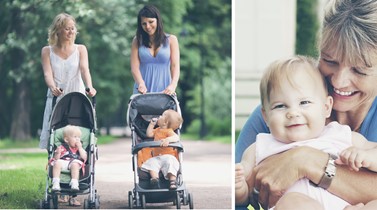Having another baby: when’s the best time?

When is the right time to add another baby to the family? Hannah Davison considers 'the gap'.
I did the maths, consulted my phone’s fertility app and questioned my sanity; but apparently – if we wanted a two-year age gap between children – it was time to get cracking. How could this be a good idea? Our fifteen-month-old son was affectionately referred to as ‘the wrecking ball’. His 91st percentile head acted as a beacon for every ledge, edge and corner in the known universe. He treated his own mortality with utter disdain and was the greatest consumer of time since the Downton Abbey season one box set. However, I soothed myself with the incantation: ‘Things will be different by the time the baby comes’. My chanting may have lacked conviction, I just couldn’t be sure if the grand plan of a two-year age gap would prove too much, too little or just enough.
How do you decide the ideal gap between your first and second children? Just for fun, let’s assume we control the foibles of our own biology and that everything will go entirely as we plan. As it is hard to imagine what stage your first child may be at when you hope to throw a newborn into the mix, let us peer into a crystal ball and see what the future might hold. What will number one be doing, and when do you need to conceive number two so they’ll arrive present and correct at the appointed time?
At 18 months old your child may...
● be mastering the art of walking, running and climbing but still may fall often.
● become more proficient at feeding themselves and using a cup.
● be having day sleeps and is likely to still be sleeping in a cot.
● not yet be ready for toilet training.
● be able to demonstrate a small vocabulary of around twenty words (particularly the word ‘no’) and be able to issue simple instructions to you.
● understand single words or two-word phrases that you use.
● experience separation anxiety when you leave them.
● love to receive individual attention, especially yours.
● demonstrate frustration and throw tantrums.
● be interested mainly in their own activities, rather than playing with others and may not play for long with any one thing.
● demonstrate less sibling rivalry and grow to play well with a sibling that is close in age.
To achieve an 18-month age gap between children, you would need to conceive when your first child is 9 months old.
At 2 years old your child may...
● be walking, running and climbing confidently with few falls.
● be proficient at feeding themselves and using a cup.
● enjoy a more varied diet.
● still have a day sleep but may have moved from a cot to a bed.
● begin to show interest in toilet training.
● be able to take off or put on some clothes or shoes.
● make short sentences and express their opinion, whether all of the words are decipherable or not.
● be able to ask or answer simple questions, follow simple instructions and understand basic reasoning.
● begin to enjoy their own independence.
● demonstrate frustration or throw a tantrum when they are not understood or things don’t go their way.
● start to develop a working memory.
● begin to share their play space but are still playing independently from others and revel in your attention.
● enjoy the role of being the older sibling and grow to play well with a sibling similar in age.
To achieve a two-year age gap between children, you would need to conceive when your first child is 15 months old.
At 2½ old your child may...
● be physically confident and able.
● be able to feed themselves well and hold a cup.
● enjoy a varied diet.
● still have a day sleep but may now be in a big bed.
● be showing interest in, or have begun toilet training.
● be able to take off or put on some clothes or shoes.
● demonstrate a growing vocabulary, forming more complex sentences and becoming better at expressing themselves.
● comprehend most of what you say and be reasoned with more easily.
● take direction and follow simple instructions.
● be more comfortable when being taken care of by others.
● enjoy some independence.
● still become easily frustrated and throw tantrums.
● be more aware of how others are feeling.
● be developing their long-term memory and a sense of humour.
● become more interested in playing with others but still play mainly on their own.
● be unwilling to share their toys or your attention.
● enjoy the role of being the older sibling, help with small tasks and grow to play well with one another.
To achieve a two-and-a-half-year age gap between children, you would need to conceive when your first child is 21 months old.
At 3 years old your child may...
● be physically confident and also becoming skilled with their hands.
● be able to feed themselves, hold a cup and fetch themselves some food and drink.
● still be having a sleep during the day but may now be giving it up.
● have begun sleeping in a big bed.
● be well on the way to becoming toilet trained and taking themselves to the toilet.
● be able to put on most of their clothes and shoes.
● have a wide vocabulary, engage in conversation and communicate their needs.
● be able to understand and follow more detailed instructions.
● better express their emotions and recognise the feelings of others.
● enjoy their own independence and be comfortable being taken care of by others.
● be stubborn or demanding at times and may still throw occasional tantrums.
● demonstrate a good memory, imagination and a sense of humour.
● be interested in playing with others but could still be possessive over toys.
● focus longer on one activity.
● enjoy the role of being the older sibling, help with some tasks and may be less likely to demonstrate sibling rivalry.
To achieve a three-year age gap between children, you would need to conceive when your first child is two years and three months old.
Of course, in addition to what may be going on with your first child, there are a litany of other factors to consider that will affect your decision. The status of your relationship, financial constraints, work commitments, health, age and any other biological factors to name a few. Deciding what the ideal age gap is will be different for every family. And then achieving it just as planned? Well, we can stop gazing into that crystal ball now and may be better off to fire it out of a cannon.
When I gave my husband the happy news we were expecting our second child, his initial confusion over whether the conversation to have another baby had actually taken place was soon buoyed by the realisation we needed to buy a larger vehicle. I’m not qualified to give any sage advice on the ideal age gap, certainly any suggestions we received on the matter did more to addle than assist. In reality, we decided that whilst we were in the realms of dirty nappies, migraine-inducing musical toys and a plethora of plastic, we were best to stay there before growing accustomed to any other alternative.
Bringing our daughter home to meet her big brother was a much-anticipated affair. We were relieved that he accepted her arrival with the curiosity and wonder we’d hoped for. That she’d had the forethought to bring him a present when she came was also particularly well-received. Certainly, he sometimes tested the boundaries as we settled into the new family dynamic, but to date, they are playmates, allies and committed makers of mess. We couldn’t have planned it better.
Hannah Davison recently returned to freelance writing after a small hiatus which saw the arrival of two young children and a dairy farm conversion in Culverden, North Canterbury.

AS FEATURED IN ISSUE 35 OF OHbaby! MAGAZINE. CHECK OUT OTHER ARTICLES IN THIS ISSUE BELOW

















